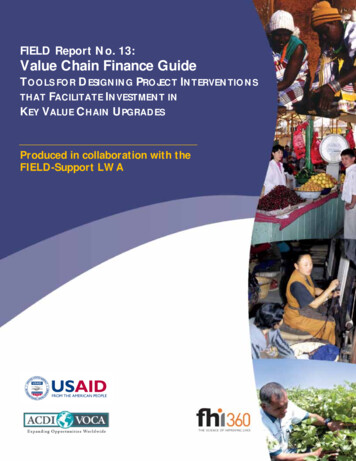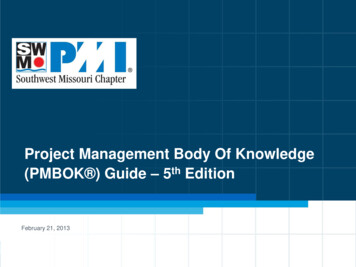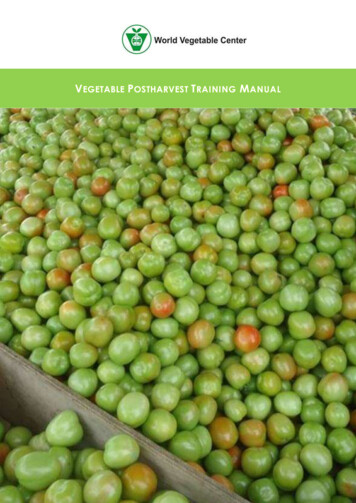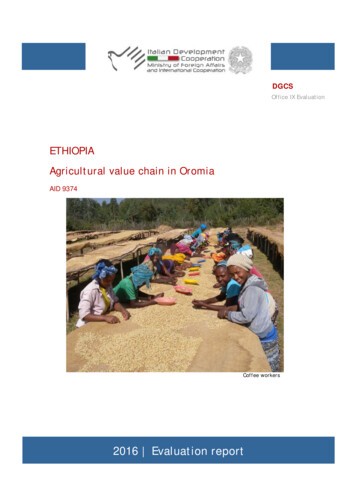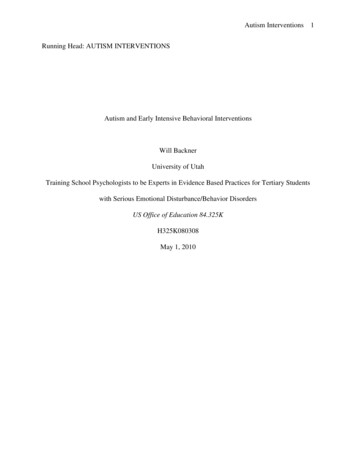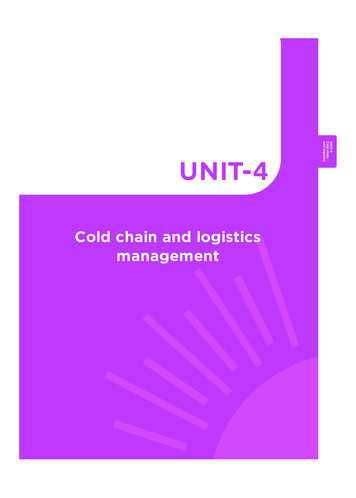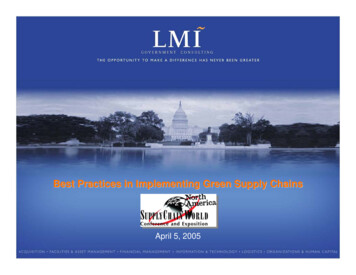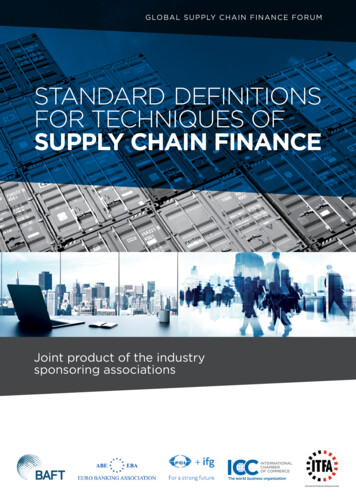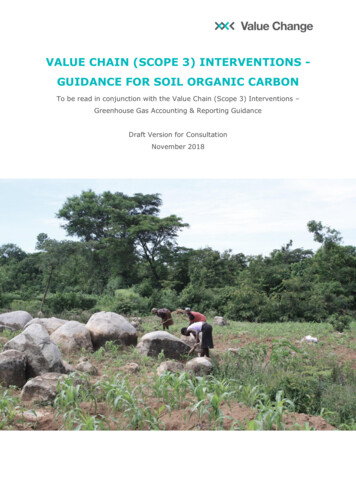
Transcription
VALUE CHAIN (SCOPE 3) INTERVENTIONS GUIDANCE FOR SOIL ORGANIC CARBONTo be read in conjunction with the Value Chain (Scope 3) Interventions –Greenhouse Gas Accounting & Reporting GuidanceDraft Version for ConsultationNovember 2018
Table of ContentsPARTNERS & ACKNOWLEDGEMENTS3INTRODUCTION4APPLICABILITY & OVERVIEW5WHO SHOULD USE THIS GUIDANCE?6PART ONE – DEFINE THE INTERVENTION8STEP 1: IDENTIFY TARGETED GOODS AND SERVICES9STEP 2: DEFINE THE INTERVENTION SCENARIO9STEP 3: DEFINE A BASELINE SCENARIO11STEP 4: DEFINE THE GEOGRAPHIC AND FACILITY BOUNDARY FOR SOC IMPACT ASSESSMENT13STEP 5: DEFINE STRATIFICATION15STEP 6: DEFINE TIME PERIOD FOR MONITORING AND REPORTING17PART ONE SUMMARY – DEFINING THE INTERVENTION18PART TWO: CHOOSE BETWEEN ACTIVITY-BASED OR DIRECT-MEASUREMENT REPORTING APPROACHES20STEP 1: CHOOSE BETWEEN ACTIVITY-BASED OR DIRECT-MEASUREMENT APPROACHES BASED ON THE NEEDS OF THEREPORTING COMPANY21STEP 2: RE-ASSESS THE INTERVENTION SCENARIO21PART TWO SUMMARY – CHOOSING A MONITORING APPROACH22PART THREE: SELECT A QUANTIFICATION METHOD24STEP 1: ASSESS SOC SCOPE AND MATERIALITY24STEP 2: REVIEW SOIL DEPTH26STEP 3: CONSIDER OTHER EMISSIONS27STEP 4: CONSIDER LEAKAGE28STEP 5: CHOOSE A QUANTIFICATION METHOD29STEP 5A: ACCOUNTING METHODS FOR ACTIVITY-BASED MONITORING APPROACHES31STEP 5B: ACCOUNTING METHODS FOR DIRECT-MEASUREMENT BASED MONITORING APPROACHES35STEP 6: BE TRANSPARENT ABOUT UNCERTAINTY AND ASSUMPTIONS37PART THREE SUMMARY: SELECTING AN ACCOUNTING METHOD39PART FOUR: REPORTING SOC CHANGE40STEP 2: EQUATION 441STEP 4: REPORT & COMMUNICATE41PART FOUR SUMMARY: DERIVING SOC422
PARTNERS & ACKNOWLEDGEMENTSThe following partners were involved in the initiation, design and development of thisguideline: Climate KIC, CDP, Danone, Mars, Livelihoods Fund, WWF, WRIThe following partners were involved in the drafting of this Guidance – Gold Standard – Owen Hewlett, Giancarlo Raschio UNIQUE – Matthias Seebauer TREES Consulting – Jacqueline Gehrig-FaselThe following provided their expertise towards the development of this document. Theirinput is gratefully acknowledged: CDP – Pedro Faria, Alberto Carrillo Piñeda WWF – Fernando Rangel Villasana Mars – Ashley Allen, Kevin Rabinovitch, Cyril Hetzel Danone – Eric Soubeiran, Flore Auge, Lucas Urbano Livelihoods Fund – Jean-Pierre Renaud Climate KIC – Riyong Bakkegaard, Konstantinos Karagkounis Gold Standard – Owen Hewlett, Abhishek Goyal, Marion Verles, Sandra Genee,Sarah Leugers, Giancarlo Raschio Quantis – Jon Dettling, Edith Martin Gold Standard Technical Advisory Committee Members – Jacqueline Gehrig-Fasel(TREES Consulting), Matt Spannagle, Dean Thomson, Tony Knowles3
INTRODUCTIONReducing the pressure on already degraded or non-agricultural land requires an increasein sustainable productivity. Currently, around 52% of agricultural lands are medium- toseverely degraded, meaning that they do not have optimum soil organic carbon level forproduction. Annually, around 10 million hectares of agricultural soils are lost (FAO andITPS 2015), despite many technical and economically viable approaches that enable therestoration of such degraded soils and restore their agricultural production capacity. Forexample, productivity can be restored through sustainable land management methods,including soil and water conservation, building soil productivity through improvednutrient cycling, use of organic matter (manure, compost, litter) and fertilizer,integration of livestock in crop production systems, agroforestry, reduced tillage andimproved fallows.It is estimated that sustainable soil management practices and rehabilitating degradedsoils could sequester 15% of annual global GHG emissions (IPCC 2014). Carbonsequestration in agricultural soils is therefore very important for climate changemitigation, while at the same time enhancing productivity, resilience and ecological soilhealth functions.In the context of agricultural supply chains, this can restore and build resilience invulnerable or degraded areas, supporting local farmers and dealing with the challengesof remote or difficult-to-access suppliers. This Guidance document provides the guidingprinciples and approaches to establishing and reporting agriculture supply chaininterventions in the context of Soil Organic Carbon (SOC).Setting and reporting greenhouse gas performance targets in agricultural supply chainsis challenging. In many cases these supply chains are deep and complex, whiletraceability and accuracy of data can be limiting factors. Many companies reporting theiremissions may seek to employ 'interventions' in their supply chains; projects,programmes and business decisions that drive sustainability and reduce emissions in keyareas.This Guidance, in conjunction with the Value Chain Interventions Guidance, provides anoverall process for defining an intervention, choosing a monitoring approach and4
accounting method, applying these methods post-implementation and including theresults in Scope 3 reporting.APPLICABILITY & OVERVIEWThis Guidance document (henceforth 'Soil Guidance') is intended to be read alongsidethe Value Chain (Scope 3) Interventions Guidance (henceforth 'Interventions Guidance').The Soil Guidance document is supplementary to Interventions Guidance, which in turnis supplementary to the Scope 3 Standard and Greenhouse Gas Protocol TechnicalGuidance for Calculating Scope 3 Emissions (henceforth the Scope 3 Guidance).This Guidance, in conjunction with the above documents, aims to raise ambition byproviding an approach through which value chain interventions are incentivized byenabling their recognition and inclusion in reporting towards performance targets, evenin cases where direct knowledge and measurement of specific value chains ischallenging. This is especially true of agricultural supply chains and interventionsinvolving SOC.Through the application of the Soil Guidance, in the context of the InterventionsGuidance, a company will be able to:1. Identify appropriate SOC interventions and design/select appropriate monitoringapproaches and accounting methods for their before and after scenarios2. Account for the net removal changes associated with a given SOC intervention3. Credibly report on the results of the intervention alongside the company’s Scope3 inventory and reporting, where appropriate4. Make narrative claims concerning the company’s role in the intervention and theimpacts arising from itThe Soil Guidance is arranged to first facilitate a decision on which approaches andmethods a company could apply to quantify and monitor SOC. It then provides furtherguidance on each approach, as well as recommend relevant tools, protocols andmethodologies. Finally, the document details how to apply numbers generated inrelevant equations in the Interventions Guidance (Figure 1).5
Figure 1: Process flow for Soil Organic Carbon Guidance for accounting and reportingPart 1 - Define your interventionDefine which goods and services areincluded and which activities will be applied.Define the scope, boundary, baseline andintervention scenariosPart 2 - Select a monitoring approachChoose between Activity-based or Direct Measurement approaches and define therationale for your selectionPart 3 - Choose a quantification approachBased on your Part 1 definitions and your Part 2 choices choose an appropriate approach toquantifying SOC and be able to justify your selectionPart 4 – Reporting SOCApply the selected quantification approach and method to derive SOC changes and reportthereon.WHO SHOULD USE THIS GUIDANCE?This Soil Guidance is aimed at any company with a Scope 3 emissions reduction targetthat seeks to account for interventions that impact total net SOC associated withpurchased goods and services. The Interventions Guidance provides further detail aboutwhere this is most relevant and applicable.The Soil Guidance sets out a step-wise process that assumes an intervention has not yetbeen implemented. In reality, many users will have interventions that are alreadyunderway, at various stages set out in Figure 1. In such cases, the Soil Guidance can beused to review the approach underway retroactively and to understand any gaps in therationale and justification for the approach chosen.6
It is noted that this Soil Guidance provides recommendations and methodologicalreferences to already existing and best practice tools, methods and information. It doesnot present a new SOC accounting method but rather compiles existing methods andguidance. References are not exhaustive; the methods and tools ‘landscape’ will evolvefurther. New methods, parameters (for example those included in the revised report1 tothe current 2006 IPCC inventory guidelines), tools and technologies can be applied underthis Soil Guidance providing the quality and quantification approaches meet theguidelines outlined in the following chapters.1The “2019 Refinement to the 2006 IPCC Guidelines for National Greenhouse Gas Inventories”report will be considered by the IPCC for adoption/acceptance at its Plenary Session in May 2019.7
PART ONE – DEFINE THE INTERVENTIONThis section describes the key elements used to define any given SOC intervention. Theprocess is important because it aligns the intervention with the Interventions Guidanceand provides the basis from which appropriate monitoring and measurement methodscan be selected.As the assumed purpose of the intervention is to enhance climate mitigation throughIn line with the approach set out in the Scope 3 Standard and the InterventionsGuidance, changes in the SOC pool are calculated by multiplying the volume of goods bya SOC emissions factor (EFSOC). This section helps define what is included in and what isexcluded from SOC intervention accounting.The intervention scope can be defined by decisions in the following main areas: The inclusion or exclusion of specific activities or practices, on the basis of theirlikelihood and the significance of their SOC impacts (both positive impacts such asSOC sequestration as well as negative impacts, e.g., emissions from fertilizer use),and their measurability (i.e., quantifiability and data availability) The geographical and process boundary of SOC impact assessment, includingstratification along soil gradients, climate zones and land management practices The time period for SOC accounting Soil depth for SOC impact assessmentChanges to supply chain SOC caused by an intervention result from the differencebetween the EFSOC for the supply prior to the intervention and after the intervention.Equation 1: SOCy Quantity of Goods Purchased * EFSOCWhere:8
SOCy SOC change in a given year associated with the production of purchasedgoods and services(tCO2e) EFSOC SOC Emissions Factor (e.g. tCO2e per unit, volume or mass of product)The following process guides defining the intervention:Step 1: Identify targeted goods and servicesPer the Interventions Guidance, the reporting company should first identify thepurchased goods or services that are to be targeted under the intervention. Under theGreenhouse Gas Protocol, only those interventions that affect goods and services thatare being purchased or can be reasonably assumed to be potentially purchased by thereporting company can be included.Output: Company able to state which goods and services are targeted by theinterventionStep 2: Define the Intervention ScenarioThe scenario under an intervention represents the intended inputs, activities andoutcomes of the interventions. The intervention scenario should be described for allrelevant activities under an intervention impacting the soil organic carbon pool in linewith the steps outlined under ‘Select and define the scope of SOC assessment’ above.Interventions can refer to a single change or to a package of different activities (basicallyfield practices) implemented within a farm or larger organizational boundary.Potentially, there are many different practices that affect the SOC pool that could beemployed and for which this Soil Guidance applies. Table 2 provides a non-exhaustivelist of practices that affect the change of SOC. The table also lists realistic baselineconditions for these practices as well as broad benchmark ranges of SOC impacts. Theuser should assess, in line with the above, which activities are inside the Scope 3boundary and which are outside. These should be presented clearly such that they canbe used correctly and transparently for accounting purposes.Table 1: Examples of typical baseline conditions and possible interventionpractices affecting soil organic carbon including mitigation benchmarksSource: adapted from Paustian et al. 2016, benchmarks from Paustian et al. 2016 and Griscom et al. 200179
Typical baselineIntervention practicesconditionsBenchmark SOCimpacts(tCO2e/ha/year)Native (unmanaged)Avoiding conversion and degradationforests and grasslandsof native ecosystemsDegraded or marginal landConvert to perennial forest orUp to 2.93 forgrassland systemsafforestation- 1.8 - 7.322.0 for grasslands4Drained, cropped organicRestore wetlandsoils05Unsustainable grazingOptimal grazing intensity0.2Degraded pasturesNitrogen-fixing species in pastures2.1Intensive tillageReduce or halt tilling, implementresidue retentionLow residue cropsSevere nutrient deficiencyExtensive bare fallowPerennials in croplands61.21.5-Windbreaks0.7-Alley cropping4.47-Natural regeneration1.5Conservation Agriculture orSustainable Agricultural LandManagement1.2Degraded agriculture landAvailable exogenousAdd amendments such as compostorganic amendmentsand biochar0.7Where an intervention includes activities impacting on SOC that are outside theGreenhouse Gas Protocol boundary, for example, for areas where the targeted goodsand services are not being grown, these may still be quantified in line with this Soil2The minus refers to avoided emissions from SOC3Based on the A/R Methodological Tool ‘Tool for estimation of change in soil organic carbon stocks due to theimplementation of A/R CDM project activities’ (link)4Conant, R. T., Paustian, K. and Elliott, E. T. (2001), GRASSLAND MANAGEMENT AND CONVERSION INTOGRASSLAND: EFFECTS ON SOIL CARBON. Ecological Applications, 11: 343-3555Due to controversy in the literature about the timing and net atmospheric effect of methane emissions inrestored peatlands, sequestration benefit from peatland restoration assumed 06This also includes rotation of perennials, use of agroforestry, and use high-C input species, cover crops7This also includes the carbon within the trees10
Guidance but should be scheduled separately (as they cannot be reported under theGreenhouse Gas Protocol).Useful for assessing what is included under the Greenhouse Gas Protocol is the WorldLCA Database, particularly Figures 2 and 3. As a general rule, any activity that is relatedto the production of the targeted goods and services and that takes place on the sameland as the production for a given year (or part year) would be considered included inthe Scope 3 boundary. Anything outside this can be quantified but not included in theScope 3 accounting under the Greenhouse Gas Protocol. Further guidance may also bedrawn from ISO 14040 and 14044, which consider the relevant boundaries for productaccounting.Output: Company states the range of activities included under the intervention andschedules out which are affecting SOC that may be included under the Greenhouse GasProtocol and which may not.EXAMPLE: An intervention could refer to the adoption of conservation agriculturewithin a cash crop production system, a combination of reduced tillage plus organicinputs to the soil (e.g., through residue retention or use of cover crops, planting of soilfertility trees, etc.) all affecting the SOC pool as well as the goods (cash crop) of thesupply chain. Or, the intervention could refer to only reduced tillage as a singlepractice.Step 3: Define a Baseline scenarioThe baseline scenario represents the land use and management practices that were inplace immediately prior to the intervention, or within a reasonable timeframe (i.e., inwhich data that can be used for this purpose is available). Ideally, the baseline yearshould be the same as the corporate inventory baseline. Since this Guidance focuses onpractices affecting the SOC pools, the baseline must represent the practices and landuses in place at that time.The approach to characterizing the baseline depends on the availability of data andjudgment as to its quality. A key principle is that the baseline should be conservative.Related to soils and SOC, a baseline is conservative if the land uses and practicesidentified prior to the intervention do not lead to an underestimation of SOC in thebaseline.11
The following approach is recommended to derive the baseline:Objective: The baseline should represent the typical agricultural management practicesand other land uses (prevailing practices) which are dominant within the largerintervention region or specific intervention areas prior to the start of the interventions.1. Use a standard land use and farming classification system to define the prevailingsystems in a standardized way. This will also allow transparent comparison ofinterventions under the Scope 3 Standard, independent from their specificgeographic locations. Table 2 provides links to widely used classification systems.Interventions in data-rich countries should use classification systems derived in therespective countries.Table 2: Links to standard land use and farming classification systemsType of classificationLinksLand use classification systems-GlobeLand30 (Link) showing land cover2000 and 2010-Global Forest Watch (Link) allowingvarious assessment of tree and forestcover, change of forest cover as well asshowing the global distribution of landcover in 2015Farming systems-FAO Farming Systems (Link) defined forSub-Saharan Africa, Middle East and NorthAfrica, Eastern Europe and Central Asia,South Asia, East Asia and Pacific and LatinAmerica and Caribbean2. Gather data to identify prevailing practices. The analyst could gather data to identifyprevailing agricultural or other land use management practices using one of the twooptions below. The choice of the approach used should be justified.oOption 1: Design and conduct a representative baseline survey specific to theintervention area(s) to identify typical management practices applied in thefarming/ land use systems identified in Step 1. An activity baseline andmonitoring survey guideline is provided as supporting documentation to thisguideline.12
oOption 2: Use existing data (own or from a third party) to identify prevailingmanagement practices in the intervention area. The existing survey should becurrent, or at least within a timeframe of 2-3 years prior to the start of theinterventions.Option 1 is recommended for the Activity-based estimation/modelling accountingapproach since such a survey can be used to provide information needed tounderstand the baseline land management and to derive input values which areneeded for some of the models. The initial SOC can be derived from availabledatabases (Table 3), such as the recently published FAO Soil Carbon Map. SinceOption 2 might not be tailored directly to the specific method selected, this approachis more suitable for the second SOC accounting approach – direct-measurementthrough soil sampling – since only a broader description of the baseline conditions isrequired. This is further discussed in Part Two. For definition purposes,it is enough tobroadly assess which option is most feasible and appropriate for the user andcircumstances of reporting.3. The credibility of baselines can be strengthened by transparent documentation ofunderlying assumptions and provision of clear justifications. Consultation withrelevant experts and stakeholders can help to ensure that the assumptionsunderlying the baseline are reasonable. Sensitivity analysis can help identify keyfactors with significant impacts on the baseline conditions and aid in identification ofa conservative baseline.Output: Company selects an option for defining the baseline scenario, based on dataavailability and practicality. This choice will later also inform the selection of monitoringapproach, in Part Two of this Soil Guidance.Step 4: Define the geographic and facility boundary for SOC impactassessmentThe Interventions Guidance requires the identification of the location (e.g., region) ofimplementation of that intervention and the facilities (e.g., farms) on which it is to beapplied. This helps to ensure that only goods and services that are within the ‘supplyshed’ of the company are captured and sets the conditions for selecting appropriatemonitoring approaches and quantification methods.13
Generally, a distinction should be made between the area in which direct SOC impactswill be accounted for as a result of the intervention, and the areas in which spill-overeffects occur due to knowledge diffusion. This can be explained by the InterventionsGuidance supply shed definition.Example: A company has plans to support dairy farms within their supply chain inlocations A, B and C within district 1. Farms in A, B and C (supply chain farms) areidentified as the area in which direct SOC impacts will occur as result of a package ofdifferent activities and practices which impact (increase) soil organic carbon. Thelocations of these farms and information on the area of implementation must bedocumented. Neighbouring farms D, E, F and G (supply shed farms), which currentlyare not in the supply chain, are identified as farms where spill-over effects due toknowledge diffusion are likely to occur, while other locations in the district areexcluded from the scope of assessment on the basis that these spill-over effects arenot directly within the company’s Scope 3 boundary (though the company may stillwish to quantify these impacts for the purposes of communicating about the overallimpact of the intervention).One outcome of this step should therefore be that the geographical scope of assessmentof direct spill-over SOC impacts has been clearly identified. The source of information foridentification of the geographical area, and where relevant, any assumptions used inidentifying the geographical area, should be transparently documented. It is goodpractice to document the following information, preferably presented as GIS vector layer(shp) or Google Earth (kml/ kmz) file. The use of simple smartphone open sourceapplications allows cost-efficient tracking of boundaries: Broader intervention region: A map with a polygon reflecting the outerboundaries within which different areas (e.g., farms) both with direct and spillover SOC impacts from the intervention occur. Intervention location: A map with one GPS point per intervention location (e.g.,farm field) or a polygon for each intervention area.Where multiple interventions are applied, for example, across multiple farming regions,then the broader intervention region should be selected in way to represent the regionalbaseline.Output: Company is able to articulate the geographic and facility boundaries.14
Step 5: Define StratificationThe definition of the geographical boundaries of the SOC intervention assessment hasimplications not only for the scale of interventions and field practices assessed, but alsofor the quantification of their specific impacts on SOC changes. The application of bothapproaches presented here, Activity-based and Direct-measurement, can vary byclimatic region, soil type and other spatially distributed factors like type of vegetation orland management.Intervention analysts should input information on the location, climate type anddominant soil type in the intervention area. This means that the definition of thegeographical location of the intervention area(s) should be sufficiently precise to enablecharacterization of climate types and dominant soil types within this area.Table 3 provides a non-exhaustive list of useful information to support a standardizedidentification of soil relevant stratification.Table 3: Databases and information sources to support standardizedstratification of the interventions location(s)InformationDescriptionReference and linkIIASA8/Version 3 - an integrated crop-The database can be accessed hereGlobal Agro-specific grid-cell databases reflecting(registration required): LinkEcologicalclimate data analysis and compilationZonesof general agro-climatic indicators,FAOcrop-specific agro-climaticassessment and water-limitedbiomass/yield calculation,assessments of yield reduction due toagro-climatic constraints, andimplementation of edaphicassessments to calculate yieldreduction due to soil and terrainlimitations8International Institute for Applied Systems Analysis15
Soil dataLocation specific topsoil as well asHarmonized World Soil Database v 1.29:subsoil information available fromLinkthis application where even ashapefile can be uploaded to matchwith a specific intervention locationSoil dataWeb app that provides free access toISRIC – Global Soil Data Facility: Linksoil data across bordersSoil dataProvides a selection of standardised/The World Soil Information Serviceharmonised soil data(WoSIS)LinkSoil carbonBest available web-based applicationFAO: Global Soil Organic Carbon Mapmap andto derive intervention location specific(Link)dataSOC stock information(GSOC)Climate dataDifferent databases available toClimate Data Online (National Centersretrieve climate data, such asfor Environmental Information (NCEI))monthly temperature, precipitation,Linketc.LocClim: Local Climate Estimator (FAO)LinkClimate dataVery large repository of datasetNASA (Link)sorted by themesClimate dataGives monthly gridded data onCru (Climate Research Unit) databasetemperature and precipitation at(link)global scaleCropImportant information to understandcalendartypical baseline as well asFAO crop calendar (Link)intervention cropping systems;provides country-specific agroecological zonesIf there is a relevant reason not to use specific sources as listed above, the followingIPCC stratification for national GHG emission estimation parameters and categorization(tier 1) could potentially be applied (Table 4), though is not recommended without asignificant reason to do so. This approach is not generally considered to be good practicebut is included for completeness. If applying this approach, a corresponding uncertaintymust thus be considered and transparently reported and users should be aware of thepotential for criticism.9 FAO/IIASA/ISRIC/ISSCAS/JRC, 2009. Harmonized World Soil Database (version 1.2). FAO,Rome, Italy and IIASA, Laxenburg, Austria16
Also note that a new revision of the 2006 IPCC Guideline is expected in May 2019.Table 4: 2006 IPCC Guideline tier 1 stratification approachInformationDescriptionReference and linkIPCCFor national (Tier 1) GHG emission2006 IPCC Guidelines for NationalStratificationestimation methods; A correspondingGreenhouse Gas Inventories Volume 4uncertainty must be consideredAgriculture, Forestry and Other LandUseClimate: Annex 3A.5 of the LinkSoil: Annex 3A.5 of the LinkBiomass: Figure 4.1 of the LinkThe FAO Ex-Act Tool has developeduseful ‘help’ application based on theIPCC stratification (Link)The source of information for identification of the geographical locations and areas, andwhere relevant any assumptions used in identifying these locations and stratification,should be transparently documented. Stratification also becomes relevant during impactmeasurement to identify strata with homogenous conditions of SOC change which willreduce any survey or sampling efforts.Output: Companies are able to clearly define the geographical and supplier boundary ofthe intervention, what is included within and what is to be scheduled separately as ‘spillover’ and how to stratify the Activity-based approach on what is being included.Step 6: Define time period for monitoring and reportingThe SOC impacts of an intervention may occur during the implementation period and/orafter completion during a post-intervention period. In addition, the nature of theintervention and the implemented field practices may also determine the appropriateduration of the SOC monitoring period to best support accounting and reporting.17
Table 5: Guiding questions to identify the appropriate time period for SOCassessmentSource: Guidance for Standardized GHG Assessment of Agriculture, Forestry and Other Land Use (AFOLU)Projects. (FAO, 2016)QuestionResponsesYesDoes the company policy explicitlyNoSelect intervention (proceed)No guidance(proceed)require quantification of SOC assessment implementationonly during the interventionperiodimplementation period?Do the intervention outputs or outcomes Select lifetime(proceed)–have a defined lifetime period?periodCan a time period be defined after which Select time period(proceed)–––assumptions affecting the baselinein whichscenario can no longer be reasonablyassumptions arejustified?likely to holdIs the answer to all of questions 1-3 ‘no’? Use a defaultperiodof 20 yearsIn addition to planning the monitoring period for the intervention, companies should alsoconsider their approach for once equilibrium is achieved (i.e. when SOC gains are attheir maximum). As SOC may be lost through changes in activity or reverting toprevious practices, it is important to continue to monitor that the practices that led tothe SOC gains are in place. Companies should therefore plan for monitoring beyond theperiod of the intervention and should not assume SOC increases are permanent. Thiscould be done with a simpler monitoring approach however, for example based only onwhether the activities and practices are still continuing.Output: Companies should be able to define the temporal scope of the assessment.Part One Summary – Defining the InterventionWith the application of the process of Part One of the Soil Guidance, a company shouldnow have: A clear statement of which purchased goods and services a
stratification along soil gradients, climate zones and land management practices The time period for SOC accounting Soil depth for SOC impact assessment Changes to supply chain SOC caused by an intervention result from the difference between the EF SOC for the supply prior to the intervention and after the intervention. Equation 1: SOC y
